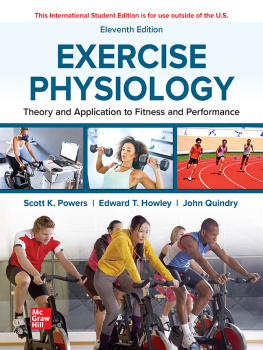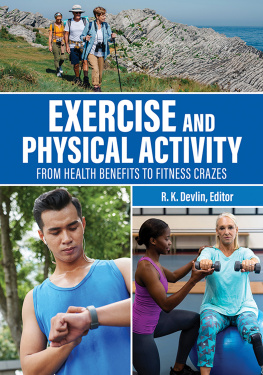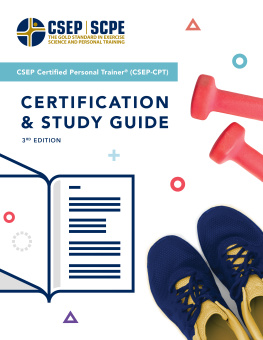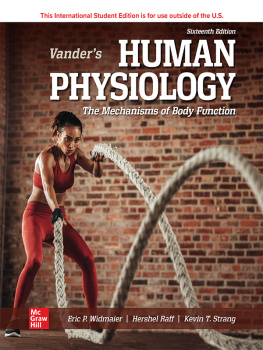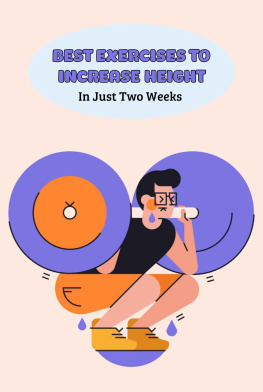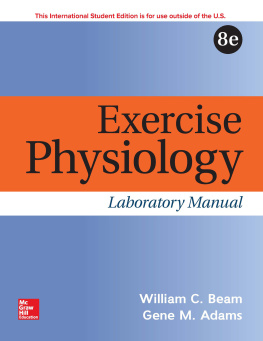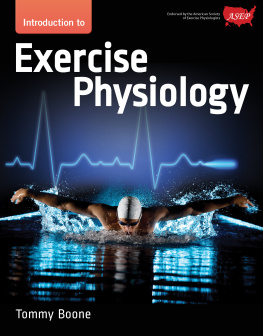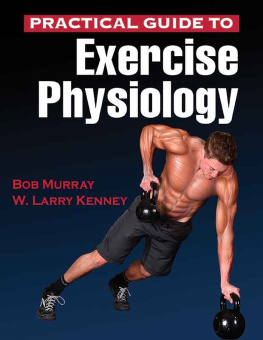Table of Contents
Cover Page

i
Exercise
Physiology
Theory and Application to
Fitness and Performance
ELEVENTH EDITION
Scott K. Powers
University of Florida
Edward T. Howley
University of Tennessee, Knoxville
John Quindry
University of Montana

ii
Copyright Page

EXERCISE PHYSIOLOGY
Published by McGraw Hill LLC, 1325 Avenue of the Americas, New York, NY 10121. Copyright 2021 by McGraw Hill LLC. All rights reserved. Printed in the United States of America. No part of this publication may be reproduced or distributed in any form or by any means, or stored in a database or retrieval system, without the prior written consent of McGraw Hill LLC, including, but not limited to, in any network or other electronic storage or transmission, or broadcast for distance learning.
Some ancillaries, including electronic and print components, may not be available to customers outside the United States.
This book is printed on acid-free paper.
1 2 3 4 5 6 7 8 9 LWI 24 23 22 21 20
ISBN 978-1-260-57092-2
MHID 1-260-57092-4
All credits appearing on page or at the end of the book are considered to be an extension of the copyright page.
The Internet addresses listed in the text were accurate at the time of publication. The inclusion of a website does not indicate an endorsement by the authors or McGraw Hill LLC, and McGraw Hill LLC does not guarantee the accuracy of the information presented at these sites.
mheducation.com/highered
iii
Dedicated to Lou, Ann, and Tiffany
for their love, patience, and support.
iv
Brief Contents
Appendices can be found in the Instructors Resources within Connect

v
Contents
vi
vii
viii
ix
x
xi
Appendices can be found in the Instructors Resources within Connect
xii
xiii
Preface
The eleventh edition of this book has undergone major revisions. Identical to all previous editions, this edition of Exercise Physiology: Theory and Application to Fitness and Performance is intended for students interested in exercise physiology, medicine, clinical exercise physiology, exercise science, human performance, physical therapy, and physical education. The objective of this text is to provide the student with an up-to-date understanding of the physiology of exercise. Moreover, the book contains numerous clinical applications including a discussion of the benefits of exercise for multiple sclerosis patients and the latest information on sports-related brain injuries.
This book is intended for a one-semester, upper-level undergraduate or beginning graduate exercise physiology course. Clearly, the text contains more material than can be covered in a single 15-week semester. This is by design. The book was written to be comprehensive and afford instructors the freedom to select the material that they consider to be the most important for their course. Furthermore, if desired, the book could be used in a two-semester sequence of exercise physiology courses (e.g., Exercise Physiology I and II) to cover the entire 25 chapters contained in the text.
NEW TO THIS EDITION
The eleventh edition of this book has undergone major revisions to include the latest research in exercise physiology. Importantly, Dr. John Quindry was recruited to join the author team to provide additional expertise in several chapters of the text. To improve the book, every chapter contains new and expanded discussions, new text boxes, new figures, updated references, and contemporary suggested readings.
New Topics and Updated Content
The content of this edition has undergone significant revision to provide up-to-date information across all three sections of the book. Specifically, each chapter has been revised and updated to include new and improved box features, new illustrations, new research findings, and the inclusion of up-to-date references and suggested readings. The following list describes some of the significant changes that have been made to make the eleventh edition more complete and up-to-date:
: This chapter underwent a major revision to provide numerous new elements including a discussion of the research process in exercise physiology, an overview of the scientific method, and a summary of the types of research performed in exercise physiology. A new segment also explains how to read and understand scientific journals articles. Further, a fresh section was added to explain how to search the scientific literature. The chapter closes with an up-to-date discussion on careers in exercise physiology and related fields.
: A new section was added to introduce the major types of ergometers used in exercise physiology laboratories. A new figure was inserted to illustrate the differences in running economy between runners varying in experience and ability.
: The chapter was revised to include an expanded discussion of the gain of a biological control system. A New Research Focus box was provided to introduce the concept of exercise-induced hormesis.
xiv
: New material has been included to explain the biological wisdom behind why skeletal muscle stores carbohydrate in the form of glycogen. New Research Focus box added to discuss the formation of free radicals in skeletal muscle fibers. New Ask the Expert box with Dr. Wayne Willis introduces a simple hydraulic model to assist students in better understanding oxidative phosphorylation.
: Addition of new A Closer Look box to discussVO2max and its verification. New information provided to discuss the role that excess postexercise oxygen consumption plays in exercise-induced weight loss. New figure added to illustrate the Cori cycle.
: This chapter underwent significant revision to include numerous new and improved figures along with an expanded introduction to the basics of endocrine and neuroendocrine physiology. Moreover, updated information was added on both glucagon and cortisol responses to exercise. New information was provided on skeletal muscle as an endocrine organ.

